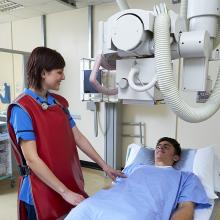
How Medical Imaging Departments Can Adhere to Current Radiation Safety Rules
As the use of diagnostic imaging exams continues to grow, radiation safety is a daily concern for radiology service providers. The number of CT exams tripled in the U.S. between 1996 and 2010, and 85 million were performed in 2020 alone. The advent of new technologies such as multidetector CT scanners that deliver up to 50% more radiation adds special urgency - in fact, 24% of all radiation exposure in the US comes from CT machines.
Maintaining a safe environment for imaging personnel and the patients they treat requires a focus on three areas: dosimetry management, regulatory compliance, and radiation safety training.
Dosimetry management. Strictly following practice and ALARA guidelines, ensuring that imaging equipment is operating properly, and paying regular attention to occupational exposure are key components of medical imaging radiation safety.
Regulatory compliance. Staying abreast of complex and changing regulatory requirements, while time-consuming, is critical to medical imaging radiation safety efforts. More than half of the states now require radiation shielding designs when installing new equipment or moving existing equipment, and more may follow. Real-time dosimetry is an invaluable tool when it comes to placing shielding and keeping employees safe.
Radiation safety training. Current certification for radiation technologists and ancillary staff requires continued education that involves training, education and evidence of competency. Such training is required for Joint Commission accreditation. Look to LANDAUER Academy for a list of courses that fulfill current radiation safety needs for personnel radiation safety.
In addition, the majority of states require a Radiation Protection Program (RPP) for all facilities utilizing ionizing radiation-producing equipment. If you don't have one yet, the LANDAUER Medical Physics team can help you develop a written RPP.


